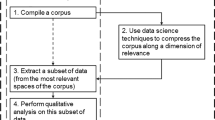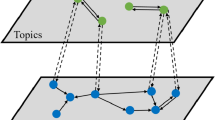Abstract
Social media data are increasingly being used for enhancing situational awareness and assisting disaster management. We analyzed the wildfire-related Twitter activities in terms of their attributes pertinent to space, time, content, and network, so as to gain insights into the usefulness of social media data in revealing situational awareness. Findings show that social media data can characterize the wildfire across space and over time, and thus are applicable to provide useful information on disaster situations. Second, people have strong geographical awareness during wildfire hazards and are interested in communicating situational updates related to wildfire damage (e.g., containment percentage and burned acres), wildfire response (e.g., evacuation), and appreciation to firefighters. Third, news media and local authorities are opinion leaders and play a dominant role in the wildfire retweet network.










Similar content being viewed by others
References
Acar A, Muraki Y (2011) Twitter for crisis communication: lessons learned from Japan’s tsunami disaster. Int J Web Based Communities 7(3):392–402
Ager AA, Day MA, Finney MA, Vance-Borland K, Vaillant NM (2014a) Analyzing the transmission of wildfire exposure on a fire-prone landscape in Oregon, USA. For Ecol Manag 334:377–390
Ager AA, Day MA, McHugh CW, Short K, Gilbertson-Day J, Finney MA, Calkin DE (2014b) Wildfire exposure and fuel management on western US national forests. J Environ Manag 145:54–70
Albuquerque JB, Herfort B, Brenning A, Zipf A (2015) A geographic approach for combining social media and authoritative data towards identifying useful information for disaster management. Int J Geogr Inf Sci. doi:10.1080/13658816.2014.996567
Calkin DE, Thompson MP, Finney MA, Hyde KD (2011) A real-time risk assessment tool supporting wildland fire decisionmaking. J For 109(5):274–280
Cameron MA, Power R, Robinson B, Yin J (2012) Emergency situation awareness from Twitter for crisis management. In: Proceedings of the 21st international conference companion on World Wide Web. ACM, pp 695–698, Apr 2012
Cheong F, Cheong C (2011) Social media data mining: a social network analysis of tweets during the Australian 2010–2011 floods. In: 15th Pacific Asia conference on information systems (PACIS). Queensland University of Technology, pp 1–16
Chuvieco E, Aguado I, Yebra M, Nieto H, Salas J, Martín MP et al (2010) Development of a framework for fire risk assessment using remote sensing and geographic information system technologies. Ecol Model 221(1):46–58
Chuvieco E, Aguado I, Jurdao S, Pettinari ML, Yebra M, Salas J et al (2012) Integrating geospatial information into fire risk assessment. Int J Wildland Fire 23(5):606–619
Collins TW (2008) What influences hazard mitigation? Household decision making about wildfire risks in Arizona’s White Mountains. Prof Geogr 60(4):508–526
Collins TW, Bolin B (2009) Situating hazard vulnerability: people’s negotiations with wildfire environments in the US Southwest. Environ Manag 44(3):441–455
Crooks A, Croitoru A, Stefanidis A, Radzikowski J (2013) Earthquake: Twitter as a distributed sensor system. Trans GIS 17(1):124–147
Csardi G, Nepusz T (2006) The igraph software package for complex network research. InterJ Complex Syst 1695(5):1–9
Endsley MR (1995) Toward a theory of situation awareness in dynamic systems. Hum Factors J Hum Factors Ergon Soc 37(1):32–64
Feinerer I, Hornik K (2014) tm: text mining package. R package version 0.6
Feinerer I, Hornik K, Meyer D (2008) Text mining infrastructure in R. J Stat Softw 25(5):1–54
Ghosh D, Guha R (2013) What are we ‘tweeting’ about obesity? Mapping tweets with topic modeling and geographic information system. Cartogr Geogr Inf Sci 40(2):90–102
Gillett NP, Weaver AJ, Zwiers FW, Flannigan MD (2004) Detecting the effect of climate change on Canadian forest fires. Geophys Res Lett 31(18). doi:10.1029/2004GL020876
Goldstein BE (2008) Skunkworks in the embers of the Cedar Fire: enhancing resilience in the aftermath of disaster. Hum Ecol 36(1):15–28
Guan X, Chen C (2014) Using social media data to understand and assess disasters. Nat Hazards 74(2):837–850
Han SY, Tsou MH, Clarke KC (2015) Do global cities enable global views? Using Twitter to quantify the level of geographical awareness of US cities. PLoS ONE 10(7):e0132464
Herrero-Corral G, Jappiot M, Bouillon C, Long-Fournel M (2012) Application of a geographical assessment method for the characterization of wildland–urban interfaces in the context of wildfire prevention: a case study in western Madrid. Appl Geogr 35(1):60–70
Huang Q, Xiao Y (2015) Geographic situational awareness: mining tweets for disaster preparedness, emergency response, impact, and recovery. ISPRS Int J Geo-Inf 4(3):1549–1568
Imran M, Elbassuoni SM, Castillo C, Diaz F, Meier P (2013a) Extracting information nuggets from disaster-related messages in social media. In: Proceedings of ISCRAM, Baden-Baden, Germany
Imran M, Elbassuoni S, Castillo C, Diaz F, Meier P (2013b) Practical extraction of disaster-relevant information from social media. In: Proceedings of the 22nd international conference on World Wide Web companion. International World Wide Web Conferences Steering Committee, pp 1021–1024
Imran M, Castillo C, Lucas J, Meier P, Vieweg S (2014) Aidr: artificial intelligence for disaster response. In: Proceedings of the companion publication of the 23rd international conference on World Wide Web companion. International World Wide Web Conferences Steering Committee, pp 159–162, Apr 2014
Kogan M, Palen L, Anderson KM (2015) Think local, retweet global: retweeting by the geographically-vulnerable during Hurricane Sandy. In: Proceedings of the 18th ACM conference on computer supported cooperative work and social computing. ACM, pp 981–993, Feb 2015
Li S, Ye X, Lee J, Gong J, Qin C (2016) Spatiotemporal analysis of housing prices in China: a big data perspective. Appl Sp An Policy. doi:10.1007/s12061-016-9185-3
Liu Y, Goodrick S, Heilman W (2014) Wildland fire emissions, carbon, and climate: wildfire–climate interactions. For Ecol Manag 317:80–96
Martínez J, Vega-Garcia C, Chuvieco E (2009) Human-caused wildfire risk rating for prevention planning in Spain. J Environ Manag 90(2):1241–1252
Massada AB, Radeloff VC, Stewart SI, Hawbaker TJ (2009) Wildfire risk in the wildland–urban interface: a simulation study in northwestern Wisconsin. For Ecol Manag 258(9):1990–1999
Padilla M, Vega-García C (2011) On the comparative importance of fire danger rating indices and their integration with spatial and temporal variables for predicting daily human-caused fire occurrences in Spain. Int J Wildland Fire 20(1):46–58
Pyne SJ (2004) Pyromancy: reading stories in the flames. Conserv Biol 18(4):874–877
Qu Y, Huang C, Zhang P, Zhang J (2011) Microblogging after a major disaster in China: a case study of the 2010 Yushu earthquake. In: Proceedings of the ACM 2011 conference on computer supported cooperative work. ACM, pp 25–34, March 2011
Rego F, Catry FX, Montiel C, Karlsson O (2013) Influence of territorial variables on the performance of wildfire detection systems in the Iberian Peninsula. For Policy Econ 29:26–35
Rodrigues M, de la Riva J (2014) An insight into machine-learning algorithms to model human-caused wildfire occurrence. Environ Model Softw 57:192–201
Rodrigues M, de la Riva J, Fotheringham S (2014) Modeling the spatial variation of the explanatory factors of human-caused wildfires in Spain using geographically weighted logistic regression. Appl Geogr 48:52–63
Schulte S, Miller KA (2010) Wildfire risk and climate change: the influence on homeowner mitigation behavior in the wildland–urban interface. Soc Nat Resour 23(5):417–435
Slavkovikj V, Verstockt S, Van Hoecke S, Van de Walle R (2014) Review of wildfire detection using social media. Fire Saf J 68:109–118
Srivastava M, Abdelzaher T, Szymanski B (2012) Human-centric sensing. Philos Trans R Soc A Math Phys Eng Sci 370(1958):176–197
Starbird K, Palen L (2010) Pass it on? Retweeting in mass emergency. International Community on Information Systems for Crisis Response and Management
Thompson MP, Haas JR, Gilbertson-Day JW, Scott JH, Langowski P, Bowne E, Calkin DE (2015) Development and application of a geospatial wildfire exposure and risk calculation tool. Environ Model Softw 63:61–72
Tsou MH, Leitner M (2013) Visualization of social media: seeing a mirage or a message? Cartogr Geogr Inf Sci 40(2):55–60
Tsou MH, Yang JA, Lusher D, Han S, Spitzberg B, Gawron JM et al (2013) Mapping social activities and concepts with social media (Twitter) and web search engines (Yahoo and Bing): a case study in 2012 US presidential election. Cartogr Geogr Inf Sci 40(4):337–348
Vieweg S, Amanda LH, Starbird K, Palen L (2010) Microblogging during two natural hazards events: what Twitter may contribute to situational awareness. In: Proceedings of the SIGCHI conference on human factors in computing systems. ACM, pp 1079–1088
Wang Y, Wang T, Ye X, Zhu J, Lee J (2015) Using social media for emergency response and urban sustainability: a case study of the 2012 Beijing rainstorm. Sustainability 8(1):25
Westerling AL, Hidalgo HG, Cayan DR, Swetnam TW (2006) Warming and earlier spring increase western US forest wildfire activity. Science 313(5789):940–943
Xu P, Wu Y, Wei E, Peng TQ, Liu S, Zhu JJ, Qu H (2013) Visual analysis of topic competition on social media. IEEE Trans Vis Comput Graph 19(12):2012–2021
Yang X, Ye X, Sui DZ (2016) We know where you are: in space and place-enriching the geographical context through social media. Int J Appl Geosp Res (IJAGR) 7(2):61–75
Young SD (2014) Behavioral insights on big data: using social media for predicting biomedical outcomes. Trends Microbiol 22(11):601–602
Youssouf H, Liousse C, Roblou L, Assamoi EM, Salonen RO, Maesano C et al (2014) Quantifying wildfires exposure for investigating health-related effects. Atmos Environ 97:239–251
Zhao Y (2012) R and data mining: examples and case studies. Academic Press, New York
Acknowledgments
This material is based upon work supported by the National Science Foundation under Grant No. 1416509, project titled “Spatiotemporal Modeling of Human Dynamics Across Social Media and Social Networks”. Any opinions, findings, and conclusions or recommendations expressed in this material are those of the author and do not necessarily reflect the views of the National Science Foundation.
Author information
Authors and Affiliations
Corresponding author
Rights and permissions
About this article
Cite this article
Wang, Z., Ye, X. & Tsou, MH. Spatial, temporal, and content analysis of Twitter for wildfire hazards. Nat Hazards 83, 523–540 (2016). https://doi.org/10.1007/s11069-016-2329-6
Received:
Accepted:
Published:
Issue Date:
DOI: https://doi.org/10.1007/s11069-016-2329-6




